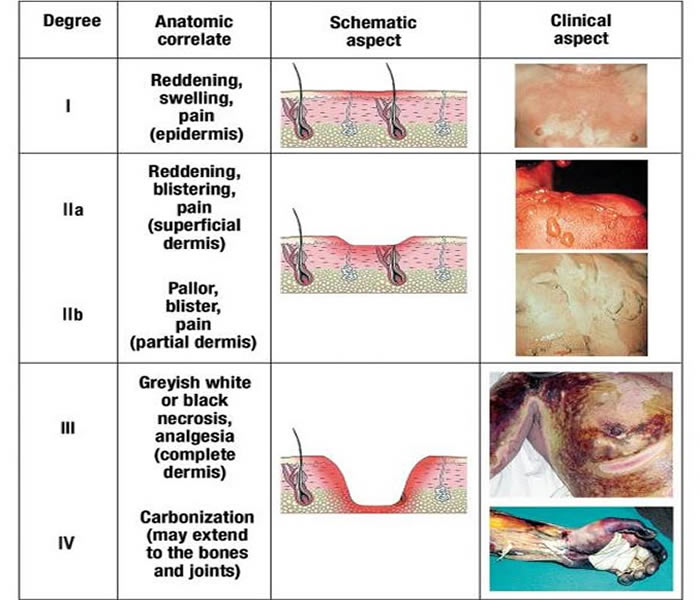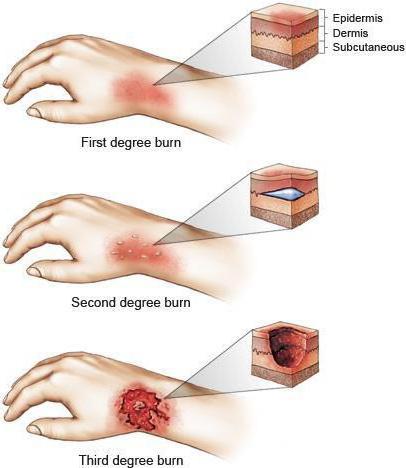

You may need to have the burn injury cleaned and the dressings replaced frequently. A trip to the hospital, however, should be considered when the burn is severe, covers a lot of the body, or when there is a high risk of infection. If the burn is not too large or too severe, then treatment can be done at your doctor's office or a clinic. Treatment for second-degree burns can vary. The area itself might be white or discolored or may look wet. It will be painful to the touch and inflamed. Symptoms of Second-Degree BurnsĪ second-degree burn will be red and there will be blisters. These burns can be superficial or they can be more dangerous and deeper.

Like first-degree burns, the causes of second-degree burns include scalding, touching a hot object, more severe sunburns, and exposure to a flame, chemicals, or electricity.
#4TH DEGREE BURN SYMPTOMS SKIN#
Second-Degree BurnsĪ second-degree burn happens when both the epidermis and a portion of the dermis - the layer of skin beneath the outer one - are injured. It can take a few days to a few weeks for a first-degree burn to heal.
#4TH DEGREE BURN SYMPTOMS HOW TO#
But if the burn injury is too painful or you just want some advice on how to treat it, a call or trip to the doctor may be warranted. Also, applying aloe vera can help with pain as can honey, lotion, or antibiotic ointments.Ī hospital visit is generally not required. However, make sure it is not too cold, as this can damage the skin. Treatment for First-Degree Burnsįirst-degree burns can be treated at home most of the time. Generally, there are no blisters, and any long-term damage to your skin tissue is rare.

The symptoms of a first-degree burn include redness, pain, and possible inflammation. Extremely hot water during a shower or bath can burn the skin, too.īurns from electrical sockets or cords can also cause first-degree burns as can burns from exposure to flames or touching something hot. If you put your hand or face too close, the steam can burn the skin. Imagine opening the lid of a steaming pot on the stove. If boiling water touches your skin, the heat will burn it. When you stay outdoors too long without sunscreen protection, the sun's UV rays can burn your skin.Īnother example of such burns, especially in children, is scalding. The main cause of a first-degree burn is mild sunburn. This type of burn injury is the most superficial burn, affecting only the outer layer of your skin, or the epidermis. First-Degree Burnsįirst-degree burns are the most common, with many people experiencing one at some point in their lives. The higher the degree, the more severe the burn. There are four different degrees of burns, and they're classified by category depending on how severely the skin gets penetrated. Roughly 73% of burn injuries typically occur at home, according to the ABA, with around 8% occurring at work, 5% on the road, and another 5% during recreational activities. Through contact with some form of electricity such as a power outlet.Through exposure to a very hot liquid or steam.According to the American Burn Association, most hospital burn patients sustained their injuries: 4 Types of Burn Injuriesīurn injuries have different root causes. Burn lawsuits ensure that you receive compensation for your injury, especially if someone else's negligence caused it. If you or a loved one has suffered a burn injury, you should contact a personal injury attorney immediately. The American Burn Association estimates that about 450,000 people are treated for burn injuries in hospital emergency rooms every year - that figure doesn't include burn injuries treated outside hospital settings, like doctor's offices or clinics. Depending on the extent of the burn, these injuries can be debilitating, changing your life in a matter of minutes. Whether you're at home or work, outside, or riding on a public bus, a burn injury can happen anywhere.


 0 kommentar(er)
0 kommentar(er)
